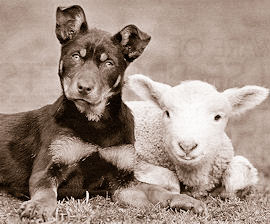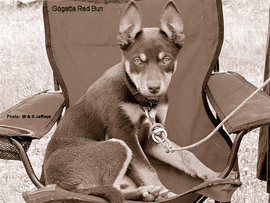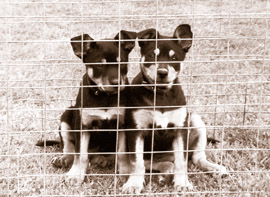

For anyone who wants an active, highly intelligent and faithful dog, the Working Kelpie makes an ideal pet, but before you decide to own a Working Kelpie you should consider whether you can give him the conditions that will in turn give you an outstanding dog.
He is bred for work, not for the show bench, and needs to use his natural energies both mental and physical. Though even the well-established pet would sooner work sheep than do anything else if you cannot give him work with stock you can substitute other things and he will not only be happy and contented but will also be a joy to own.
He needs companionship, though he is content to stay for hours on the chain, he also needs to be with you for some time each day and he needs exercise, walks or games with a ball or a stick. It is no use expecting this dog, which has been bred to work, to stay outside the house without anything to do or to think about. Inevitably, he will set about looking for an occupation; this can be chasing cars, trying to ‘work’ them as he would control sheep.
He may settle for visits to the local school, where he will find the companionship and interest he craves. (This is one of the best places for meeting the local dog-catcher who will remove him smartly to the local dog pound.)

A Working Kelpie makes a fine family dog gets on well with ‘his’ children and because they are naturally gentle almost all Working Kelpies live peaceably with other family pets.
All dogs need training and intelligent dogs such as the Kelpie love to learn and take great pleasure in working for their owner's approval. Be sure that as puppies they never have the chance to do wrong or to go where they are not permitted. If you make sure the pup can't roam, chase cars, bail up the postman or join him on his rounds, visit neighbours or the local school or park - he will never miss these so-called pleasures and will never require severe punishment to stop him.
It is much better to manage things so that the pup is not tempted into trouble than to let him get himself into trouble and then punish him. While this is an ideal way of ensuring that a puppy cannot develop bad social habits, nevertheless it is not sufficient to, fill the needs of the growing young dog.
Physically preventing a pup from doing the wrong thing is a ‘negative’ type of training (e.g. NOT allowing him to go out by himself or make his own friends, etc.) and as the pup grows into a dog he needs a more positive approach from his owner, so that he learns to obey and co-operate with his owner in spite of his own natural inclinations to possibly do otherwise. This is where ‘positive’ training must take over - teaching the young dog to obey commands such as coming when called, staying, lying down, walking on the lead without pulling, not going off by himself, etc.
The easiest way to learn how to give this training to a young dog is to join one of the many obedience training clubs, where qualified instructors will help and advise in has training. Most: of these clubs operate at the weekend and details of their locations can be obtained from Dogs New South Wales, Telephone 02 9834 3022 or 1300 728 022 (NSW only). This training is a MUST for the Kelpie kept as a pet.

A Kelpie needs a balanced environment in which to develop satisfactorily. By this we mean that he needs stimulation by training and handling and some peace and quiet in which to reflect on his lesson. In other words, the Kelpie which is over-stimulated by constant excitable activity (children playing etc.) will develop into a highly-strung excitable animal, unlikely to be reliably obedient.
Conversely, the Kelpie who rarely sees his owners during the day (such as the ‘working’ family who are only at home in the evenings) will be likely to develop bad social habits such as excessive barking through boredom, working the fences by running up and down, and so on.
These dogs are over-reacting to normal suburban activities which a dog in a properly balanced environment would cope with in a normal fashion. For example, where a dog has an owner with him during the day, there is an opportunity for the owner to correct the dog when he begins to bark at the normal routines of the neighbours such as passers by, backyard activities etc.
When the dog is alone, there in no one to tell him when his barking alarms are being overdone, and the situation develops into that of the dog which barks incessantly all day long, producing complaints from the neighbours, Therefore, it is not an ideal situation for a Kelpie to be raised by a family who are all absent during working hours each day.
The working kelpie needs discipline and is bred to take the discipline of the chain, because he never before known this type of restriction, a pup will often struggle to get free when first tied up.
Don’t be alarmed: just leave him alone. Provided he has kennel or box to retreat into – is tied in an area where he cannot get this chain tangled around something - and has perhaps a big bone , he will as .the sheepmen say, ‘soon give in to the chain’. This is a vital part of his training and cannot be over-emphasised.
It is wise, until the pup is about 18 months old, to tie him up on a suitable chain every day, even if he is only chained for about twenty minutes. In addition, he should always. be restrained at night, This is not only good training but it also means that your grown dog can literally be tied up with a peace of string, left without complaint in your car and taken visiting with the knowledge that he can be settled anywhere and will not be a nuisance wherever he his.
The Kelpie should never be free at night. To be a pet or a companion he has to be educated to our ways. Dogs naturally tend in he awake at night and if not made to rest, like their owners, they will be guarding or prowling and quite likely noisy. They need the rest' - make .sure they get it.
Right, from the start, the pup must be shut up at night. If he is eventually to sleep outside, he should also be chained, to condition him to the fact that when old enough he will be chained to his kennel at night.
Avoid keeping your Kelpie on a short lead for extended lengths of time, which is just as bad as never tying him up at all. Legally, it is an offence for a dog to kept chained on a short chain (3M' or so) for a 24-hour period without being let off for exercise. A good compromise for people without fences or no suitable arrangements for keeping their Kelpie confined is the runwire. A stout clothesline is attached at either end to large tent pegs which are driven into the ground, Thy dog’s chain is attached to this and he is thus able to run up and down with a restricted amount of freedom.
Be sure that his kennel or a suitable cover is available to him and that he is not exposed to the continuous hot summer sun without some shade. The runwire can be as long or short as is convenient – 7M to 9M is a recommended length. This system, of course, is no substitute for proper exercising of the dog.
Kelpies are easy to housetrain as they are naturally clean. Once a pup understands the house is not t a place for puddles and messes he will make no mistakes. If you have not previously trained, a pup, to be ’clean’ in the house, our advice to you is not to keep a pup to long inside, do not play too long with him in the house, as excitement makes for mistakes.
If he commences to squat in the house, pick him up quickly and take him out. Praise him extravagantly when he makes his puddle in the right place and scold him just a little if he is too quick for you and makes a mess inside.
One other successful method of housetraining is to cover the floor of his sleeping room with newspapers for the pup to soil on. Each day, reduce the amount of newspaper until the only bit left is that near the door, which the pup will soil.
Finally remove the last piece of newspaper by the door and the pup will soil stand by the door and cry for the paper. Immediately, let him out to be clean and praise him when he is successful. This procedure will take from a few days up to a week or so.
Working Kelpies are easy to train as they like to lease you. It is mainly a matter of not allowing them to acquire bad habits. Most pups tend to go through a stage just as teenagers do, where they ‘try you out’. It is most important not to relax the discipline, remember to chain the pup and make sure he doses not disobey you; see to it the pup gets no opportunity to get away onto the street.

This stage does not last very long and he reverts to his willingness to please. It is important to remember that regardless of how well bred he is – a spoilt disobedient Kelpie is of no value either as a companion or as a working sheepdog in the country.
The Working Kelpie Council has a booklet which gives advice about the general principles of early training. It is entitled Basic Obedience for the Sheepdog and is available by contacting the WKC.
If you want a dog that will little more than eat and sleep and be available if and when you want him then there are other breeds; but you are prepared to give just a little then the Working Kelpie is the dog to own as your pet.